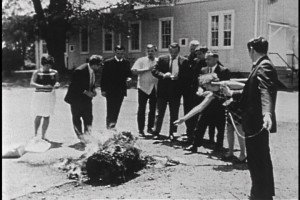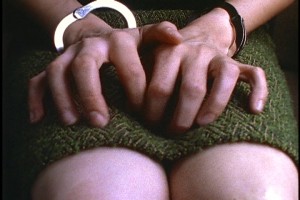Published in San Francisco Cinematheque’s monograph Lynne Sachs Retrospective 1986 – 2010
& Speaking Truths with Film: Evidence, Ethics, Politics in Documentary
Letter from Bill Nichols
August 31, 2004
Dear Lynne,
It was such a pleasant surprise to see you again after so many years at the benefit for the Anthology Film Archives. Your work has clearly gelled into an oeuvre of some note since we were both, passingly, at San Francisco State University in the late eighties.
I am very glad you were able to send me a copy of Investigation of a Flame, your film about the destruction of draft records in Catonsville, Maryland by Daniel and Philip Berrigan and the seven others. It is quite a compelling work. I think it is extremely revealing in terms of the motivations and consequences of what took place. This was a part of the history of the 1960s that was mediated to us by papers and networks that were in a near hysteria, fueled partly by a fear that the social fabric, and the social contract, was being torn asunder by people who would not accept lies and hypocrisy, and partly by a government that was determined to impose its will on a public vulnerable to a rhetoric of fear—from the specter of Communism that time, the specter of terrorism now. The past does return, doesn’t it, but not always as farce.
I was just getting back from two years in Kenya, where I had gone to teach in a secondary school and to rethink my trajectory toward a medical career, when that and other events occurred. The assassination of Martin Luther King had taken place just before I was due to leave and the May-June events of 1968 in France were at their height. I came back partly with the optimistic thought of resuming my studies, but now in cinema, and partly with the pessimistic dread that my plans would be postponed by the draft. I was eligible but also a bit clueless about what my options were. I had heard news of draft resisters and had friends in Paris who worked with draft deserters; I knew I could go to Paris instead of back to the U.S., but I also knew it would alter the rest of my life more than I could imagine.
Events like the one you reexamine flickered past on the limited news that reached my remote village. Their function on an ethical plane of giving witness to an alternative view of community and relationships was not lost on me, not after having followed King’s efforts in some detail. But this had to be filtered out from the general hysteria, scapegoating and demonizing. I never had access to the interiority of the event, certainly not with the density and complexity that you are now able to offer. You give a delicacy to the representation of what happened that really enlivens memory and enriches history. The sensitivity and strength of the “perpetrators” is quite impressive. They know what they are doing and why and have given it such careful thought. They remain vividly aware of what they wanted to do, how intensely they wished to cause no physical harm to any individuals who may have worked at the draft center, and how visible the symbolic level of their acts had to be. You give these acts, through the archival footage and the very personal, moving testimony of those who participated, an exemplary power: they come to stand for, in your film, those acts we sometimes undertake when we are driven by conscience and a compelling need to give witness to an alternative sense of social responsibility.
I felt at times that Investigation of a Flame bore similarity to The Thin Blue Line with the poetic, evocative quality Errol Morris instills, but without the romantic overtone that his use of Philip Glass’ music imparts. You withhold that kind of musical dramatization; your film remains within a realm of historical witness and physical action that is not now, as it was not then, embroidered with the richness of musical tapestry. The actuality of the event, which in The Thin Blue Line remains, in fact, invisible since no one saw the murder that is at the heart of the film, is rendered visible again. Your rapid pans of flowers and other objects, in an evocative color that evokes the past more than a photo-realist present, have an austere, provocative quality to them. Unlike Glass’ music, whose “work” for Morris’ film is clear, these images of garden flowers challenge us to determine what “work” they do. They do not soften the sharpness of a still vital historical past. They may reduce the pleasures that one ponders upon stepping up to the box office window, but they reward in ways I am still in the process of contemplating.
What I do not need to contemplate but remember is that the efforts of people like the ones you feature did have a profound impact on me. What to do about the draft? I went back to the classes in theology I had had at Duke and to the questions of a just war that St. Augustine had raised so long ago and wound up writing an extremely long explanation of why I felt I had to request status as a conscientious objector to my own draft board on Long Island. Remarkably (because very few boards paid much heed to such requests), my request was granted and, through a series of additional vicissitudes, I was able to resume my studies and continue my opposition to the war in Vietnam without having to enter the Army. People like the Catonsville 9 had a direct influence on the shape of my life and you have now given the shape of their actions and the clarity of their thoughts a brilliant frame. It is a slightly better world now that your film is part of it. Thanks again, so much, for sending it to me.
Bill Nichols is an historian and theoretician of documentary film.


